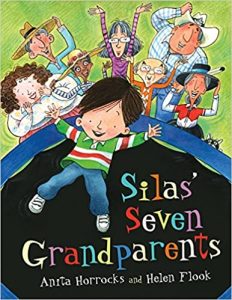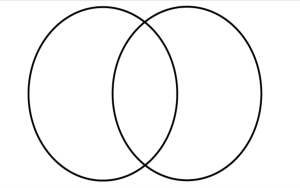Gender Identity & Gender Roles

Author(s): Anita Horrocks & Julie Flet
Links:
Amazon: https://amzn.to/2OfE3vD
Indigo: https://bit.ly/2WrmNGD
Social Justice focus: Family configuration
Synopsis: Silas is a little boy who has seven grandparents. While this brings him much joy, it also poses challenges. All his grandparents are eager to be involved in his life, and it can at times be overwhelming. Silas comes up with a creative solution. The illustrations and storyline reflect racial and cultural diversity as well as exploring the complexity of non-traditional family dynamics.
Lesson Plan: Brooke Ezekiel
Primary/Junior/Intermediate Lesson Plan (Abbreviated Template)
Consecutive and Concurrent Programs
Unit/Topic: Every Family is the Same and Every Family is Different!
Grade: 4
Lesson: The focus of this lesson is to introduce students to different social justice issues present in society by introducing them to different family dynamics and various types of families. Students will identify similarities and differences between themselves and other students in the class in order to better understand the people around them, and to learn that it is important to embrace and celebrate these differences.
Curriculum Areas: Language/Mathematics
Curriculum Expectations:
Language
Mathematics → Data Management and Probability (p.74)
Overall Expectations
- Collect and organize discrete primary data and display the data using charts and graphs
- Read, describe, and interpret primary data and secondary data presented in charts and graphs
Specific Expectations
- Collection and Organization of Data: Collect data by conducting a survey or an experiment to do with themselves, their environment, issues in their school or the community, or content from another subject, and record observations or measurements
- Collection and Organization of Data: Collect and organize discrete primary data and display the data in charts, tables and graphs
- Data Relationships: Compare similarities and differences between two related sets of data, using a variety of strategies
Learning Goal(s):
- Students will explain, “what makes a family a family” in their own words.
- Students will explain the terms “same” and “different”.
- Students will provide specific examples between their own families and their peer’s families.
- Students will appreciate and respect other’s similarities and differences.
- Students will participate in the group discussions.
- Students will cooperatively collaborative with their peers.
- Students will use organizational tools to organize their ideas.
Success Criteria:
- I can identify specific similarities and differences between my family and my peer’s families.
- I can understand the benefits of being different and unique within my classroom and society.
- I can be respectful of others.
- I can attentively listen to my peers and participate at the appropriate times.
- I can use a T-Chart and Venn Diagram to compare similarities and differences.
MODIFICATIONS / ACCOMMODATIONS:
Modifications → N/A
Accommodations → I could provide students with extra prompts or questions while completing the T-Table and the Venn Diagram in order for them to understand how to properly use these charts to organize their data. I can allow students to use technology to record their information, or explain the information orally and get another student or myself to scribe for them. In addition, I could pair certain students together for the partner or small group section of the lesson in order to benefit their individual learning.
Minds-On
Description → I will begin the lesson by telling students that we are going to be reading a picture book as a class called Silas’ Seven Grandparents. However, before we begin reading the book, we are going to have a class discussion. I will draw a graphic organizer on the board with the question “What makes a family a family?” in the middle. Students will have two minutes to think about it themselves, two minutes to discuss with a partner and then they will have the chance to share their ideas with the class (Think-Pair-Share Activity). I will write students thoughts and ideas in the graphic organizer on the board. Once we have completed the graphic organizer answering the question, “What makes a family a family?” we will read the picture book in a read aloud together as a class.
Minutes: ~20 Minutes (~10 Minute Think-Pair-Share, ~10 Minutes Reading)
Task: Students will be doing a Think-Pair-Share Activity to respond to the question “What makes a family a family?” I will write their answers in the graphic organizer on the board. Following the Think-Pair-Share, we will read the picture book, Silas’ Seven Grandparents together as a class.
Assessment: Assessment FOR Learning
Assessment: Anecdotal (participating, listening attentively, collaboration)
Action
Description → After reading the picture book together as a class, we will review the terms “same” and “different” as a class. I will use examples from the picture book to reiterate the terms after students had shared their thoughts and ideas. For example, the grandparents in the picture book are the same because they all love Silas but the grandparents are different because some wear glasses and some do not or because some are tall and some are short. After clarifying these terms, I will split the class up into partners or small groups (depending on the number of students in the class).
Each partner or small group will receive “Question Cards.” Each card will have a specific question. Students will take turns reading the question from the “Question Card” aloud. After asking each other the question and sharing their responses, students will record whether their answers were the same or different on the T-Chart. Once the students have gone through all the cards, they will tally up how many responses were the same and how many were different. Students will repeat this process with three different partners or small groups, recording the number of same results and different results each time. Once students have completed the “Question Cards” three times with different groups, they will return to their seats for a group discussion.
As a class, discuss whether students had answers mostly the same or mostly different (most students should have more answers that are different in comparison to their partners or small groups). Ask the students:
- Is it okay to have different opinions and responses in comparison to your classmates?
- Is it good that people in the class are different?
- What would happen if everyone in the class was the exact same?
By completing this activity and asking these questions, students should have a better understanding of similarities and differences among students, as well as have a better understanding of uniqueness and how every individual is unique.
Minutes: ~30 Minutes (~3 Minute Discussion, ~7×3 = 21 Minutes Question Cards, ~5 Minute Discussion)
Task: Review the terms “same” and “different” as a class. Students will get in partners or small groups and work through the “Question Cards”, while recording the number of same and number of different responses. Students will repeat this process three times with different partners. After completing the table, calculating the number of same and different responses, we will have a class discussion about the student’s answers. I will explain to the students that it is a good thing that people got different answers because we want everyone to be different and unique.
Assessment: Assessment FOR Learning
Assessment: Anecdotal (on task, collaborating with others, participating, listening attentively)
Consolidation
Description → After having a class discussion on similarities, differences and uniqueness present in the class, we will relate this information back to Silas’ Seven Grandparents. How is Silas’ family the same and different to yours? For example, I have grandparents who love me, which is the same as Silas, but my grandparents don’t take me to the museum, which is different in comparison to Silas. If students are willing to share, they can come up with similarities or differences that they notice between themselves and Silas. This will demonstrate to students that although we are different, we have similarities, but that it is okay to be different.
Give students the Venn Diagram handout with instructions. Get them to choose a partner that they haven’t worked with yet (different that the three previous partners). Have a discussion with your partner about your family. In the middle section where the circles meet, include three similarities between your family and your partner’s family. In either side of the circles, write three things that are different about your family and your partners. Students can use the questions from the “Question Cards” if they need some examples of questions.
Students will hand in their Venn Diagram once finished as an exit card from class.
Minutes: ~15 Minutes (~5 Minute Discussion in Relation to Silas, ~10 Minutes Venn Diagram)
Task: Relate the information of similarities and differences back to the picture book, Silas Seven Grandparents. Students will complete the Venn Diagram by coming up with similarities and differences between their families and their partner’s family. Students will hand in their Venn Diagram once completed.
Assessment: Assessment FOR Learning
Assessment: Exit Card (check for comprehension – similarities/differences and data organization)
MATERIALS:
- Silas’ Seven Grandparents Picture Book (can borrow from library)
- Question Cards (written on Q-Cards, prepared before class)
- T-Table Same/Different (printed for students before class)
- Handout à Venn Diagram and Instructions (printed for students before class)
REFLECTION: (CANNOT BE COMPLETED UNTIL AFTER THE LESSON)
- Were my students successful in meeting the learning goals and success criteria? How do I know?
- Did my instructional decisions meet the needs of all students? If not, what are my next steps?
- What worked well and why?
- What will I do differently in the future when teaching this lesson? For the subsequent lesson?
- What are the next steps for my professional learning?
RESOURCES
Teaching Tolerance. Retrieved from: https://www.tolerance.org/classroom-resources/tolerance-lessons/every-family-is-the-same-every-family-is-different
*Lesson Plan Ideas Were Taken from This Resource
Appendix 1: Questions for Question Cards
Questions for “Question Cards”
What is your favourite food?
What is your favourite season?
Where is one place you would love to visit?
In what month is your birthday?
What is your favourite subject in school?
What is your favourite family holiday?
What is something your family likes to do together?
How many brothers and sisters do you have?
Does anyone in your family speak a language other than English?
Can you speak a language other than English?
How old are you?
What is your favourite colour?
How do you get to school?
Appendix 2: T-Table for Same/Different Results
T-Table to Record Same/Different Results
|
|
Same |
Different |
|
Partner 1 |
|
|
|
Partner 2 |
|
|
|
Partner 3 |
|
|
Appendix 3: Handout for “Every Family is the Same and Every Family is Different” Lesson
My Name: _________________________________________
My Partner’s Name: ________________________________________

Instructions: With your partner, look at the diagram above. In the space where the two circles meet (middle section), record three similarities between your family and your partner’s family. In the other spaces on either side, write three things that are different about your family and your partner’s family.

